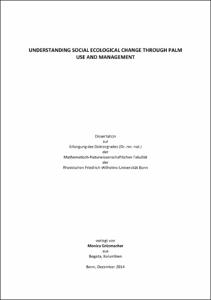Understanding social ecological change through palm use and management

Understanding social ecological change through palm use and management

| dc.contributor.advisor | Weigend, Maximilian | |
| dc.contributor.author | Grüzmacher, Monica | |
| dc.date.accessioned | 2020-04-20T21:30:43Z | |
| dc.date.available | 2020-04-20T21:30:43Z | |
| dc.date.issued | 31.03.2015 | |
| dc.identifier.uri | https://hdl.handle.net/20.500.11811/6443 | |
| dc.description.abstract | As people change their livelihood preferences, they change the way they relate to the natural resources around them. Anticipating and managing these changes, where possible, is a major challenge for sustainable land-use planning and natural resource management. This is most evident in the Amazon, a region of immense biological and cultural diversity but also a region of rapid change and transformation, quickly integrating through transportation infrastructure (roads, harbors, airports, etc.) with other South American regions and the rest of the world. This project analyzes social and ecological change taking place in indigenous settlements of the Amazon region, as they transform their subsistence economies to fit into a western model of living. It uses social ecological systems as a framework to identify and explore the linkages between changes in these two domains, and aims at understanding natural resource management from the perspective of the user and the utilized resource. This, we argue, requires an understanding of collective decision making (governance) of the variations in land and resource use in a community governed in a specific way, and of the response of forests to small-scale human intervention. The way decisions are taken and the way a group of people structure their governance system will affect the ecological system in different ways. We observed fast transformation and diversification of formerly indigenous communities and fast-track integration into western systems of organization resulting in hybrid governance systems with different combinations of traditional and western ways of social organization and resource management. Palms are an ideal study group because their use and ecology is well documented throughout the region and have more recently become an important source of income for many Amazonian populations. Changes in the management of three utilized palm species served as indicators of change in the social ecological system. We investigated palm abundance and management in the three land-use categories: cultivation areas, moderately disturbed forest, and low disturbance forest. Palms are not sown from seed or transplanted into cultivation areas rather they are passively cultivated (protected from fire, weeds, pests, falling branches, etc.). Although palm species are appreciated either for commercial or domestic purposes, seldom did we observe or document active cultivation taking place. In forested areas the most abundant of the three, Socratea exorrhiza, recognized as a generalist or oligarchic species, showed a positive response to moderate levels of human intervention. The second most abundant species, Astrocaryum chambira, is a near generalist, with more restrictions for its dispersion and establishment than S. exorrhiza, and therefore a less favorable response to moderate levels of intervention. Abundance of Phytelephas macrocarpa was the lowest; as a soil specialist its distribution is uneven and its overall response to intervention most difficult to assess. Changes in palm management betrayed a general shift from a view of cultivation areas as the community’s pantry to a view of cultivation areas as the sum of individually owned plots where only commercially valued species are harvested. The distinction between the three zones was blurred in the community with greater access to the west, there was a pressure towards privatization, to erase the traditional zoning regulations, since both palms and land are seen as a commodity. Indiscriminate extraction is taking place in forested areas and in cultivation areas pressure and conflicts are increasing and leading to formalization of property rights and new forms of representation, thus pushing integration further. Transportation infrastructure will continue its expansion, the pressure for oil and mineral extraction will increase in the Amazon and it will be necessary to accept and understand these paths of change in order to minimize the negative consequences that they might have for the social ecological system as a whole. | en |
| dc.language.iso | eng | |
| dc.rights | In Copyright | |
| dc.rights.uri | http://rightsstatements.org/vocab/InC/1.0/ | |
| dc.subject | palms | |
| dc.subject | indigenous management | |
| dc.subject | amazon | |
| dc.subject | colombia | |
| dc.subject | governance | |
| dc.subject.ddc | 570 Biowissenschaften, Biologie | |
| dc.title | Understanding social ecological change through palm use and management | |
| dc.type | Dissertation oder Habilitation | |
| dc.publisher.name | Universitäts- und Landesbibliothek Bonn | |
| dc.publisher.location | Bonn | |
| dc.rights.accessRights | openAccess | |
| dc.identifier.urn | https://nbn-resolving.org/urn:nbn:de:hbz:5n-39548 | |
| ulbbn.pubtype | Erstveröffentlichung | |
| ulbbnediss.affiliation.name | Rheinische Friedrich-Wilhelms-Universität Bonn | |
| ulbbnediss.affiliation.location | Bonn | |
| ulbbnediss.thesis.level | Dissertation | |
| ulbbnediss.dissID | 3954 | |
| ulbbnediss.date.accepted | 11.03.2015 | |
| ulbbnediss.institute | Zentrale wissenschaftliche Einrichtungen : Zentrum für Entwicklungsforschung (ZEF) | |
| ulbbnediss.fakultaet | Mathematisch-Naturwissenschaftliche Fakultät | |
| dc.contributor.coReferee | Hornidge, Anna Katharina |
Dateien zu dieser Ressource
Das Dokument erscheint in:
-
E-Dissertationen (4465)




